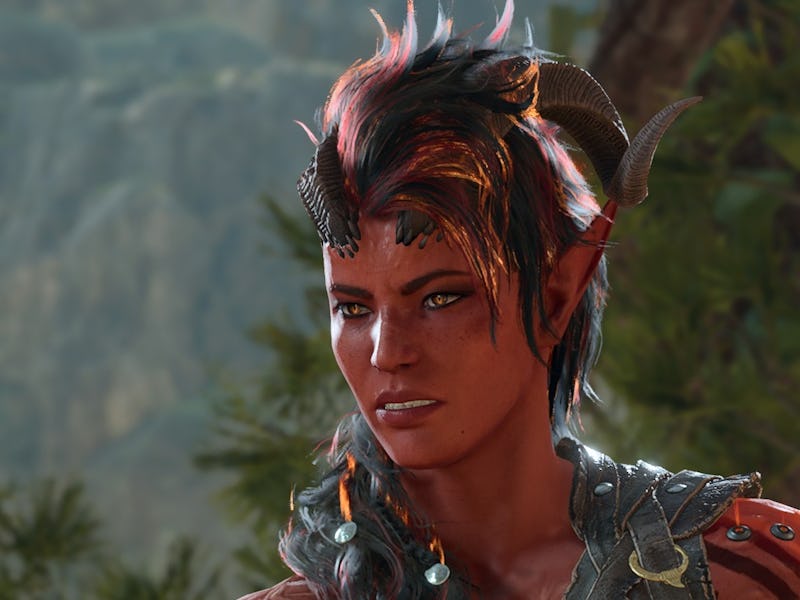Baldur's Gate 3 Can't Overcome D&D's Worst Flaws
They can’t all be critical hits.

For good reason, Baldur’s Gate 3 is a massive critical and commercial success. Its characters are complex and vivid, its world is full of intrigue, and it offers unparalleled freedom for players to engage with it on their own terms. But it could be so much better if it weren’t built on such a shaky foundation.
Like Baldur’s Gate 3, Dungeons & Dragons 5th edition is an extraordinarily popular game. Unlike Baldur’s Gate 3, it isn’t a particularly good one. Compared to older editions, D&D 5e is far more flexible and encourages improvisation. That’s part of why it works so well in popular play shows like Critical Role. But what makes for a good podcast is different from what makes a good game.
Baldur’s Gate 3 might be too good a game for its D&D roots.
Baldur’s Gate 3 is about as good as a game can be with 5e strapped to its back. But compare it to the studio’s previous titles, and it’s clear how much the system is weighing it down.
The problems start with character creation. In Larian’s Divinity: Original Sin 2, making your character is a freewheeling affair where you can mix and match skills to your heart’s content. Want to play a greatsword-wielding warrior who drinks blood to gain health and turns enemies into chickens? Have at it, champ!
Boot up Baldur’s Gate 3 and it’s a very different scenario. Here, you pick a class that defines the boundaries of your character and then add a few ability points that give bonuses to certain dice rolls. Your choice of weapons and spells are severely constrained, and because of how leveling up works in D&D, you don’t necessarily know what you’re signing up for. Depending on what class you pick, you may unlock new spells, gain abilities, or increase your hit points, but you won’t know until it happens.
D&D ties your abilities, both in and out of combat, to your main stats. Your Charisma score determines how effective some classes are with spells, but it also affects your ability to smooth talk or intimidate other characters. It’s a needlessly restrictive system and one that makes building a useful character and a fun one two totally different things.
Baldur’s Gate 3 takes some steps to make combat within D&D’s staid class system more rewarding, but its tweaks can only play at the edges of what D&D already allows. In combat, every character gets one Action, one Bonus Action, and a set movement distance. No exchanges or substitutions allowed — unless you happen to pick a class that grants an additional attack or action. It’s a huge step down from Divinity: Original Sin 2’s Action Point system, which assigns a point value to every move you make and lets you run wild as long as you stay within your budget.
Baldur’s Gate 3 can’t come close to the freedom of Divinity: Original Sin 2’s combat.
Maybe these things don’t annoy you as much as they do me. After all, I have the hots for Lae’zel, so plenty of people would question my judgment. But the biggest problems with D&D aren’t quibbles with combat, they’re the basis of its story.
Baldur’s Gate 3 inherits D&D’s Forgotten Realms setting, which feels far less imaginative than the world of Rivellon in Divinity: Original Sin 2, with its mortal deities, persecuted mages, and flesh-eating elves. Despite the presence of the brain-hungry cephalopods Baldur’s Gate 3 revolves around, D&D is a much more familiar type of fantasy — and one with a history of describing its denizens using base racist tropes.
Wizards of the Coast, D&D’s owner, has made strides to strip the game of its racist subtext in recent years, but it’s so ubiquitous it’s impossible to eliminate completely. In Baldur’s Gate 3, NPCs and party members alike constantly hurl slurs at each other. Mistrust of certain races forms the backbone of entire quests. The common defense of this type of fantasy racism is that it’s meant to show its perpetrators are bad characters or help players confront real-world issues, but I’m not buying it.
Leaning on fantasy bigotry is a boring way to portray conflict, and if you need convincing that racism isn’t okay, I’m not sure Baldur’s Gate 3 is going to fix your heart. Maybe if you’ve never had such hate directed at you, playing as a tiefling could be a teachable moment, but for players from marginalized groups, having a Druid hurl slurs at you isn’t necessarily how you want to wind down after a long day.
Thanks for the healing, Shadowheart, but can you cool it with the Githyanki stuff?
The problem goes even deeper. Setting aside the overt racism, some of your first opponents are a group of goblins and a Drow, who are evil by virtue of their race. You can choose to side with them, but doing so is explicitly evil and involves the murder of unarmed civilians and children. The heroic option, on the other hand, is to infiltrate their camp, witness how they’re portrayed as mentally and morally inferior, and then slaughter them.
The depiction of some people as inherently monstrous is so deeply ingrained in fantasy that it likely doesn’t read as odd to many players. It’s not a problem that Baldur’s Gate 3 created — it’s one it couldn’t find anywhere in the Forgotten Realms to escape from.
Baldur’s Gate 3 isn’t a didactically racist game, nor is it a mechanically empty one. That Baldur’s Gate 3 can succeed despite its central flaws is a testament to Larian’s exceptional design and writing sensibilities. But while it does its best to transcend its D&D roots, I can’t help but wish it had shed them entirely.
This article was originally published on